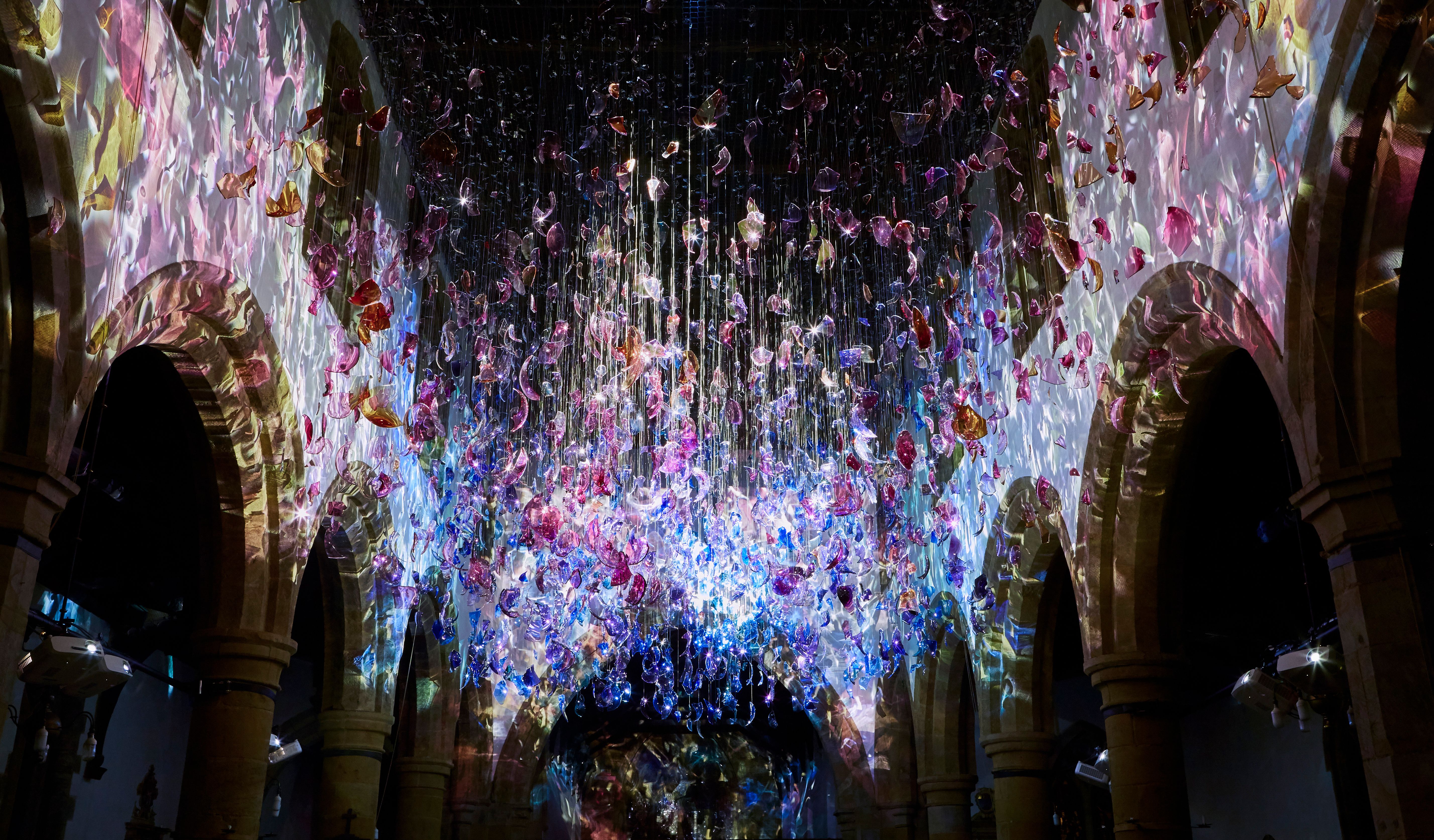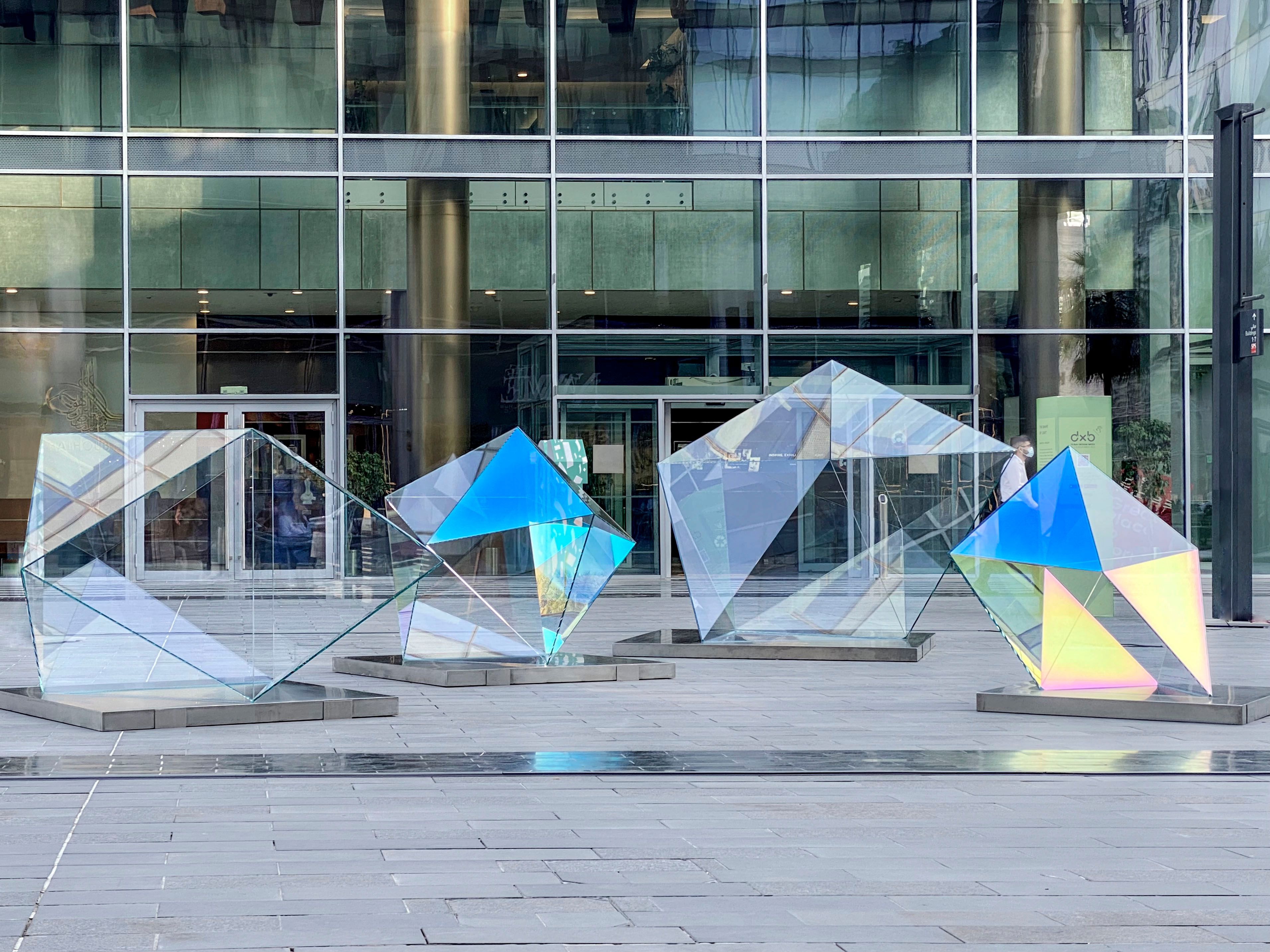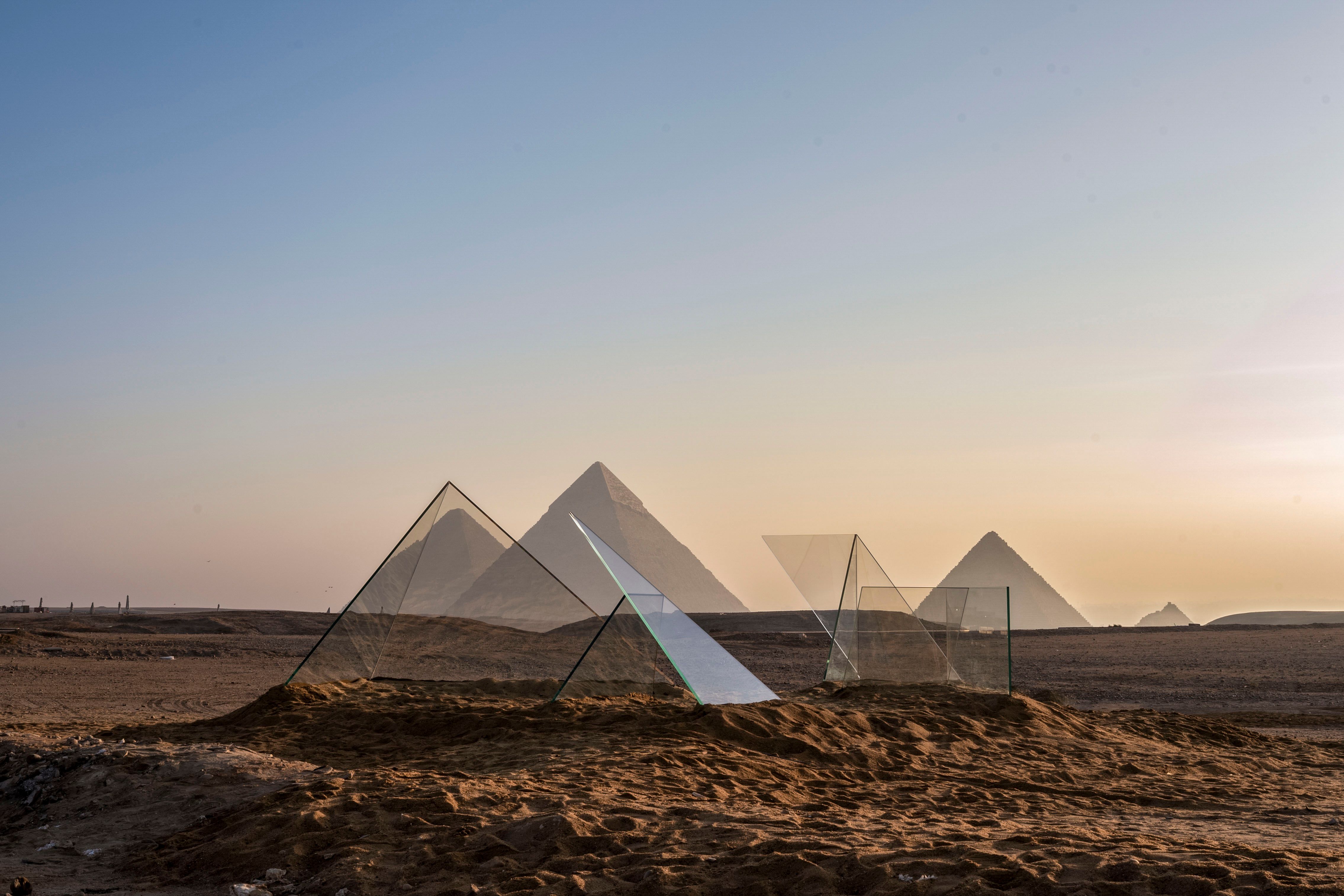
Shuster + Moseley is the conceptual brainchild of couple Claudia Moseley and Edward Shuster, who create immersive installations that employ light to pose questions about both the origins of the universe and our place within it. Their respective academic backgrounds in art and philosophy come together in these environments, which invite the viewer into a meditative state in which questions about time, individual consciousness and our increasingly symbiotic relationship to progressive technologies are brilliantly posed. Reappropriating the media of technological apparatus, these works attempt to explore what the duo refer to as an ‘alchemy of light’ – deep-diving into meditative aspects of individual consciousness, while simultaneously inviting the viewer to critically ponder abstract notions of both an archetypal past and limitless speculative futures. In this sense, they play very much with ideas relating to the stream of time, temporality and cosmology – employing the language of light in order to synthesise engagement with both Eastern meditative traditions and the outer limits of techno-science. As such, they regularly collaborate with scientists working in neuroscience and imaging technologies, as well as architects, engineers and technicians from across the globe, to create their often awe-inspiring site-specific works. In this interview with Culture Collective, the two artists discuss the technological interface as a medium through which to reflect upon the nature of consciousness, the vagaries of optical enlightenment, and the creation of sci-fi relics from future worlds.
What first drew you both to light as a medium and how does your partnership work?
Claudia Mosely: My interest in light came from an interest in analogue photography and being in the dark room, as well as a family background in film. I first started experimenting with light through the enlarger in the darkroom, removing the negative to create cameraless photographs and then removing the lens to play with the optics it created on the paper. I was so entranced by the photographic process that I then looked to recreate the optical light play through installations that deconstructed ready-made photographic apparatus. I met Ed when he was studying philosophy, and we were both struck by this synchrony of light, and how it was such an evocative and pervasive symbol.
Edward Shuster: Light signifies consciousness, and is also information. When we talk about a medium, or media, we are always thinking about things –embodiments – that mediate light in this most abstract sense. Our knowledge is deciphered from reading the shadows on the wall of the cave. Hence the framing of reality through the puppet mastery of light-technologies. But light also has its hidden aspects – the internal sun of the imagination, the secret lights of the body.

Is your work intended to activate presence in the viewer and engender a sense of being a small element in a vast cosmos?
Edward Shuster: There is definitely a sense in which the work can engender a sense of wonder, but we don't really set out with this intent. I think the approach is more like a yogic practice – a weaving between the phenomenological point of consciousness of the viewer, on the one hand, and the informational light that projects to create the atmosphere or environment of our lifeworld on the other. The context for a work is always the way in which these two lights are interfaced, and how this interfacing renders a reality. So there’s a tendency for it to reflect big cosmological or neurological ideas because the practice enacts this generalized diagrammatics where the context is abstracted to the most fundamental of dimensions.
You have spoken about your work as attempting an alchemy of light, tuning the ambience and tonality of mind in relation to the surrounding environment – can you unpack that conceptual drive?
Claudia Moseley: We consider the exposure of light as something that not just takes place on the surface of photographic paper, but also on the mind and body. This takes place in natural light, where our bodies and minds are enriched by the nutrients of sunlight, but also when we look at our screens as sources of information and that information is conveyed through a network of light - satellites, telescopes, cameras, phones.. - a kind of physiological shift takes place. We attempt to reintroduce the body into this optical ‘enlightenment’ by mediating particular hues and frequencies of light to create an ambience.
Edward Shuster: If we take the ‘extended mind’ thesis seriously, then as mind extends into our environment, it does so in such a way that enables a kind of reciprocal ‘tuning’. This tuning is like the tuning of an instrument but in terms of resonances with dimensions of reality that run behind the appearance of things.There is a sense that the way reality is framed to us – with this particular headset we have on – is a rendering by a framework of interfaces that can be played with at the most abstract and fundamental of levels. The meditative schools have already instructed the techniques as to how to peel away the layers of enframing. This is what the alchemy of light refers to – to treat light as consciousness and information, and to suspend the frequencies of our given reality, which means to attune towards those secret lights of the hidden dimensions.
Given the interest and employment of techno-science and neurology in your work - would you say you are artists exploring the cutting-edge of human evolution, and speculative futures?
Edward Shuster: This is certainly a core part of the practice: to consider how we project. In many respects the world just is the brink of destruction – this knife point edge where every technology is both poison and cure. What we experience now, as a hyperdrive of alienation and disorientation, is the accelerated externalisation of our calculative faculties. I think the great hope is that this drive can lead to the drawing out of what is incalculable to the human, which has great evolutionary potential.

How much do you think a viewer has to understand about the concepts behind your works to be impacted by them?
Claudia Moseley: It is a really important aspect to us that our work has an inherent beauty - something that draws the viewer in to appreciate the work and allows it to soak in. This way the interpretation can be their own, we hope that they can allow it to speak relatively to them, their context, their consciousness.
Edward Shuster: We’re quite conscious to construct works where the initial reaction or the initial point of entry for a viewer is as open as possible, so a viewer can approach with zero knowledge and have an experience from which the conceptual meaning should then unfold. That’s the diagram: the point of consciousness that is implicated in the work is brought into relation with a light source that is mediated by some interface, and any conceptual deepening is abstracted from how that interfacing is contextualized, layered or peeled away and opened. Our work frequently and intentionally invokes optical resonances that are intended to be gazed upon in a meditational context.

Your glass monoliths talk about the opening of individual consciousness in relation to a cosmic time – what is your take on individual consciousness?
Edward Shuster: Individual consciousness is a great mystery because it is like the sun: you can't look at it directly. The sun is blinding and consciousness is a hidden interiority, but it illuminates everything, it is in relation to everything. Cosmic temporality is fascinating, firstly for the simple reason that we are caught in the attentional apparatuses of the present clock time, media time... But it’s obvious from the vantage of the psyche that personhood extends temporally through vast histories and, certainly, is in intimate relation with archetypal forces.
In your 'anti-prisms' work you talk about creating future relics from the technological age – are you inspired by science fiction?
Edward Shuster: We were very inspired with the idea of future relics by JG Ballard’s Crystal World : not just because of the obvious aesthetic parallels to some of our work, but more so because of the approach to the idea of time, technology and embodiment, and how Ballard used the idea of crystals as a kind of active metaphor for this thinking.
Claudia Moseley: We also had an amazingly synchronistic moment when we were in residence with ONI and working out how we wanted to visualise nano-scale neuro-science. Ed was reading the Three Body Problem and a passage that described the visual embodiment of how I’d been trying to explain my vision for a virtual neural network we were working on was wonderfully described in it. Aside from the futuristic angle, I am very interested in the concept of relics from the perspective of the future looking back to the past (our present) which for me is rooted in anthropology. We conceived of these future relics as remnants of the technocene – this age of technology and architecture that supercedes the anthropocene and the pervasive materials are glass and light. So with that, we imagine these geometries and forms that might be discovered as artifacts of this epoch.

What is the most profound response you have had to your work?
Claudia Moseley: Sometimes its just silence, that the viewer wants to take a moment to sit with our work is a very profound and meaningful response. We also got a ‘Wow!’ from our son when we took him to see ‘Body of Light’ - it's so important to us that kids are able to get something out of it as well as adults, so he helps keep us on a level.
Find out more about Shuster + Moseley here
Images (top to bottom): Portrait of the artists by Roman Scott; Horizon of Day and Night, hand-cut laminated optical glass, low-iron glass, steel base. 2020, photography by Roman Scott; What Matters (The Scattering), 2,300 suspended fragments of hand-blown glass bubbles, steel cabling, digital projectors. 2017; Antiprisms, precision-cut, bevelled and hand-bonded optical glass and low-iron glass, steel base. 2021; Plan of The Path of Light (In The House of Hidden Places, optical glass and low-iron glass, steel base, 2021, photography by Hesham Alsaifi.